Charles E W Bean, Diaries, AWM38 3DRL 606/274A/1 - 1918 - 1941 - Part 13
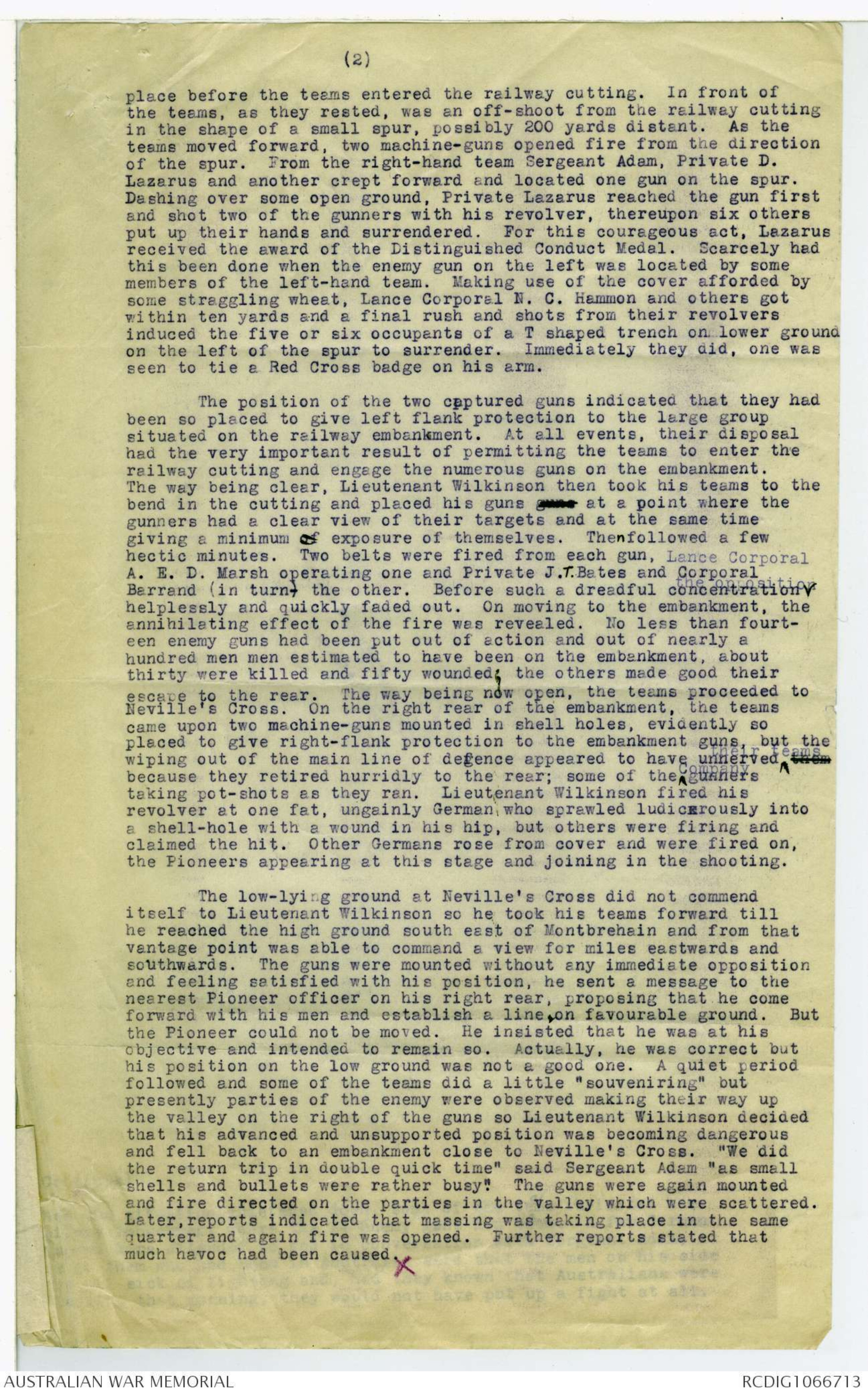
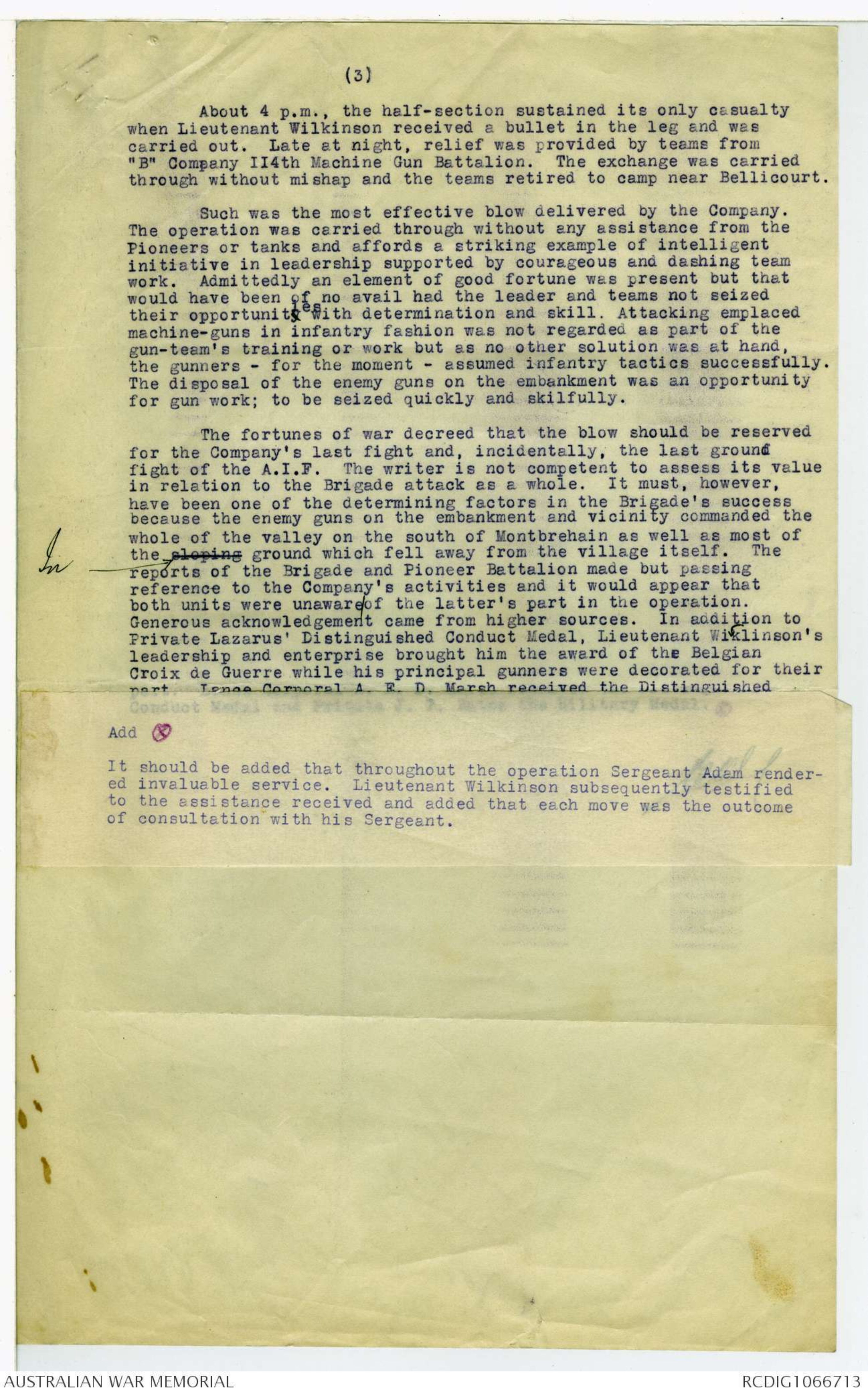

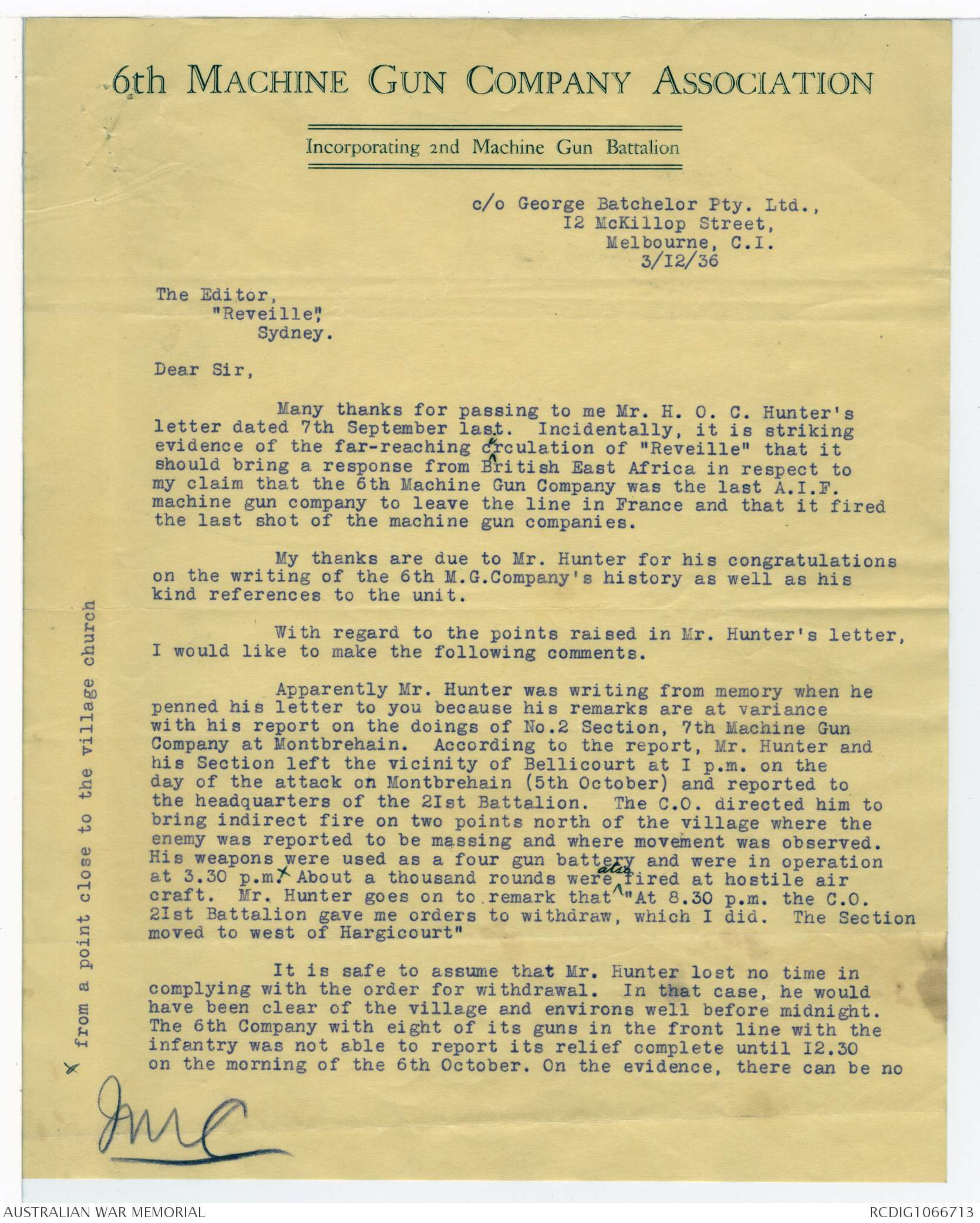
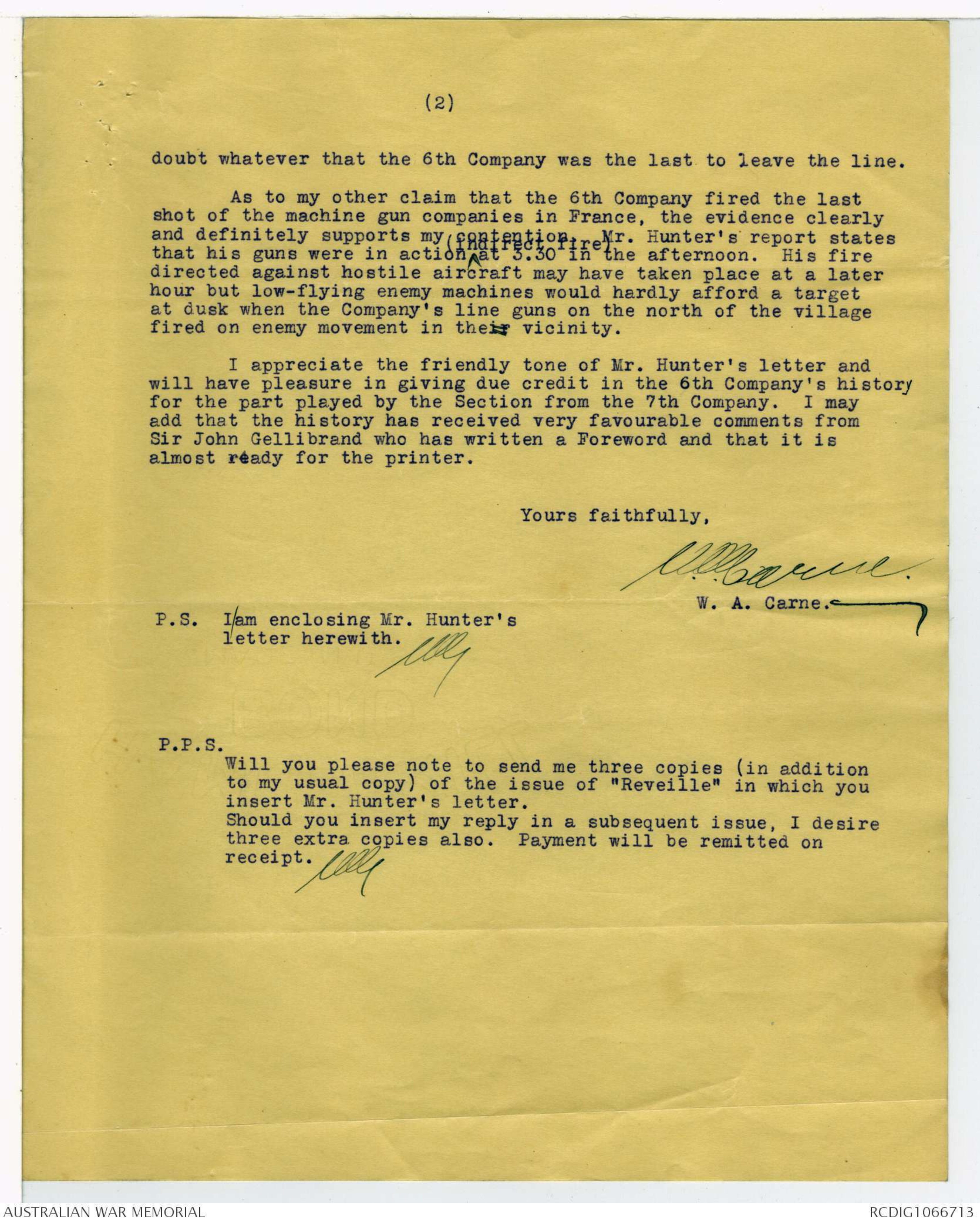
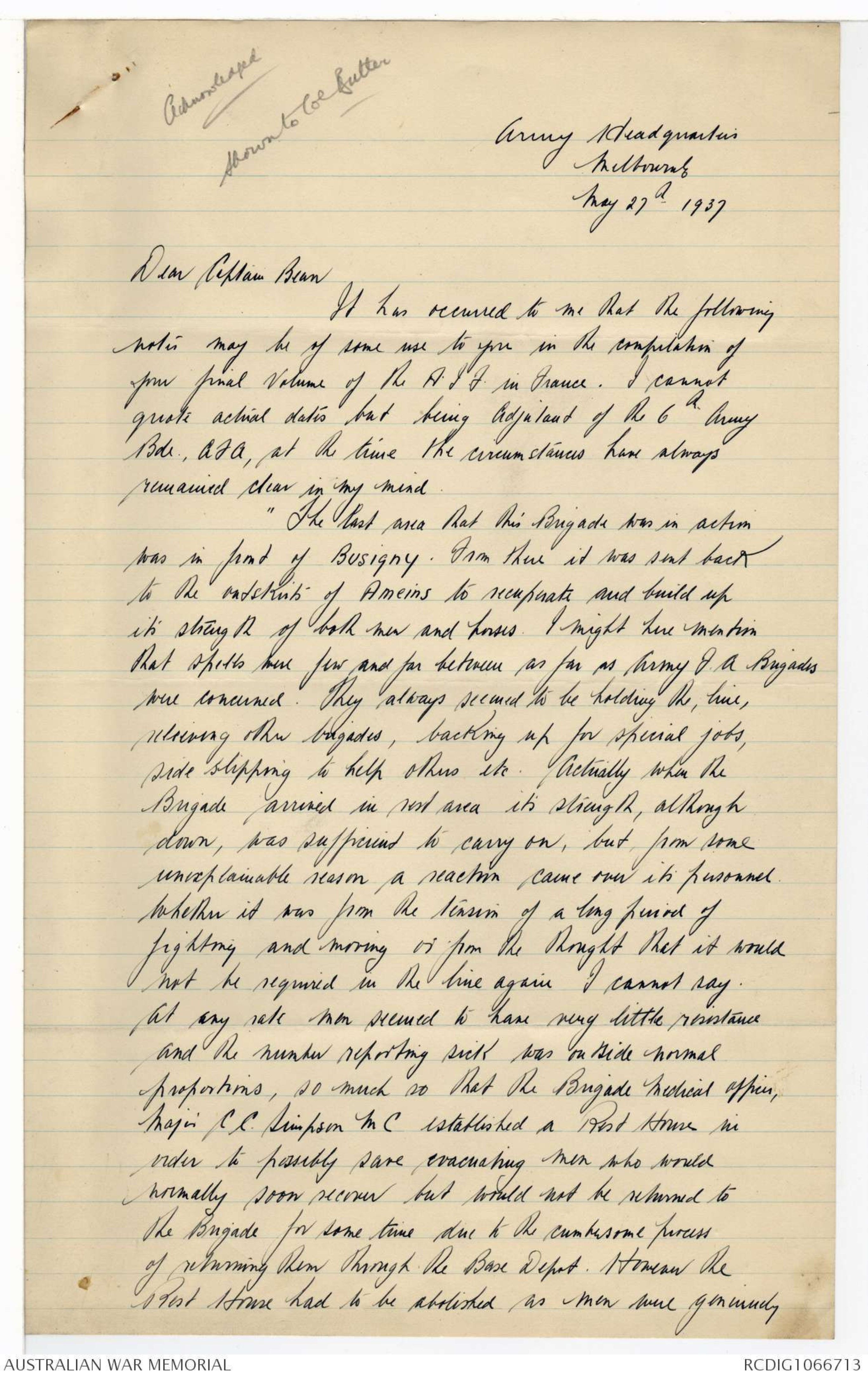
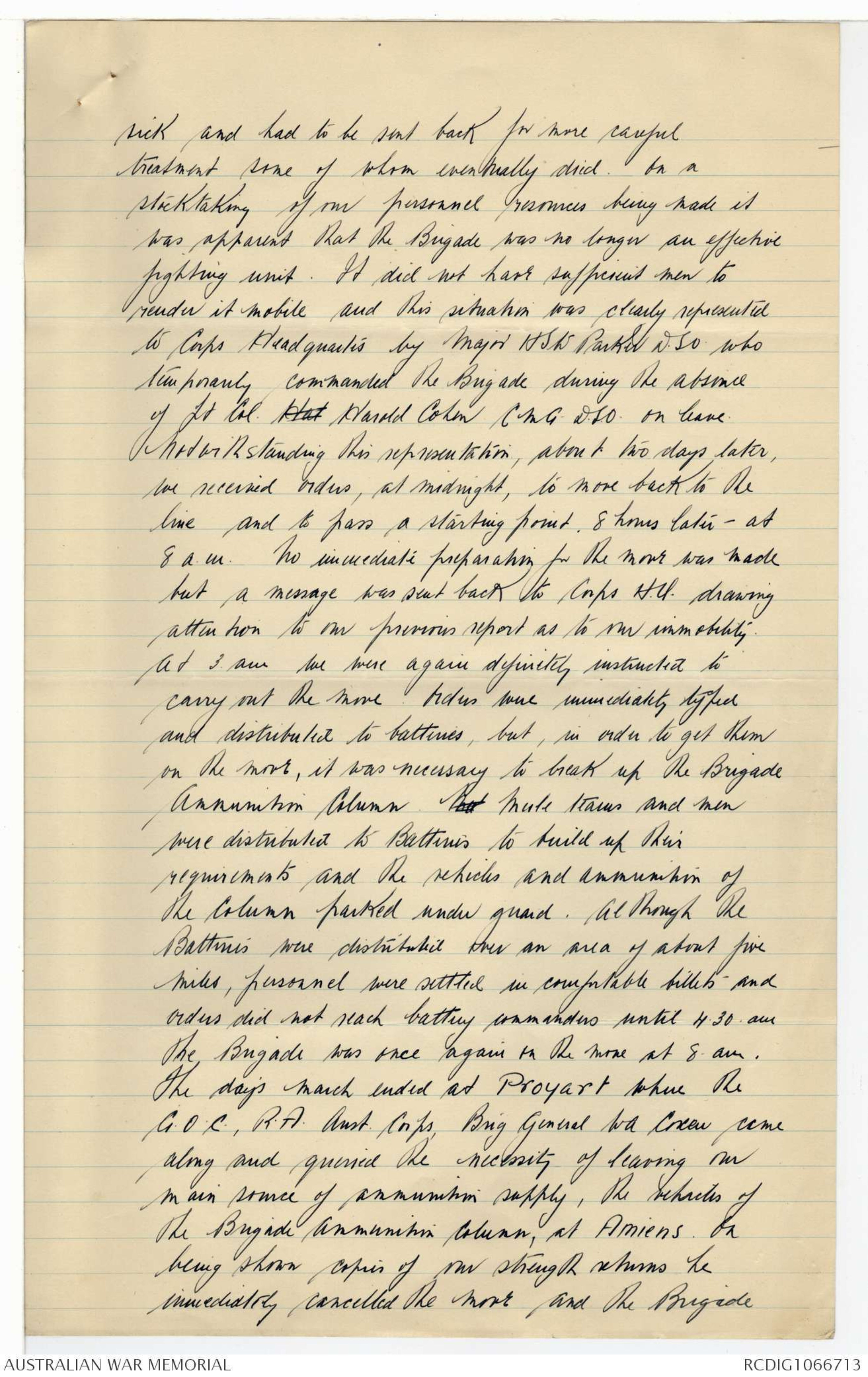
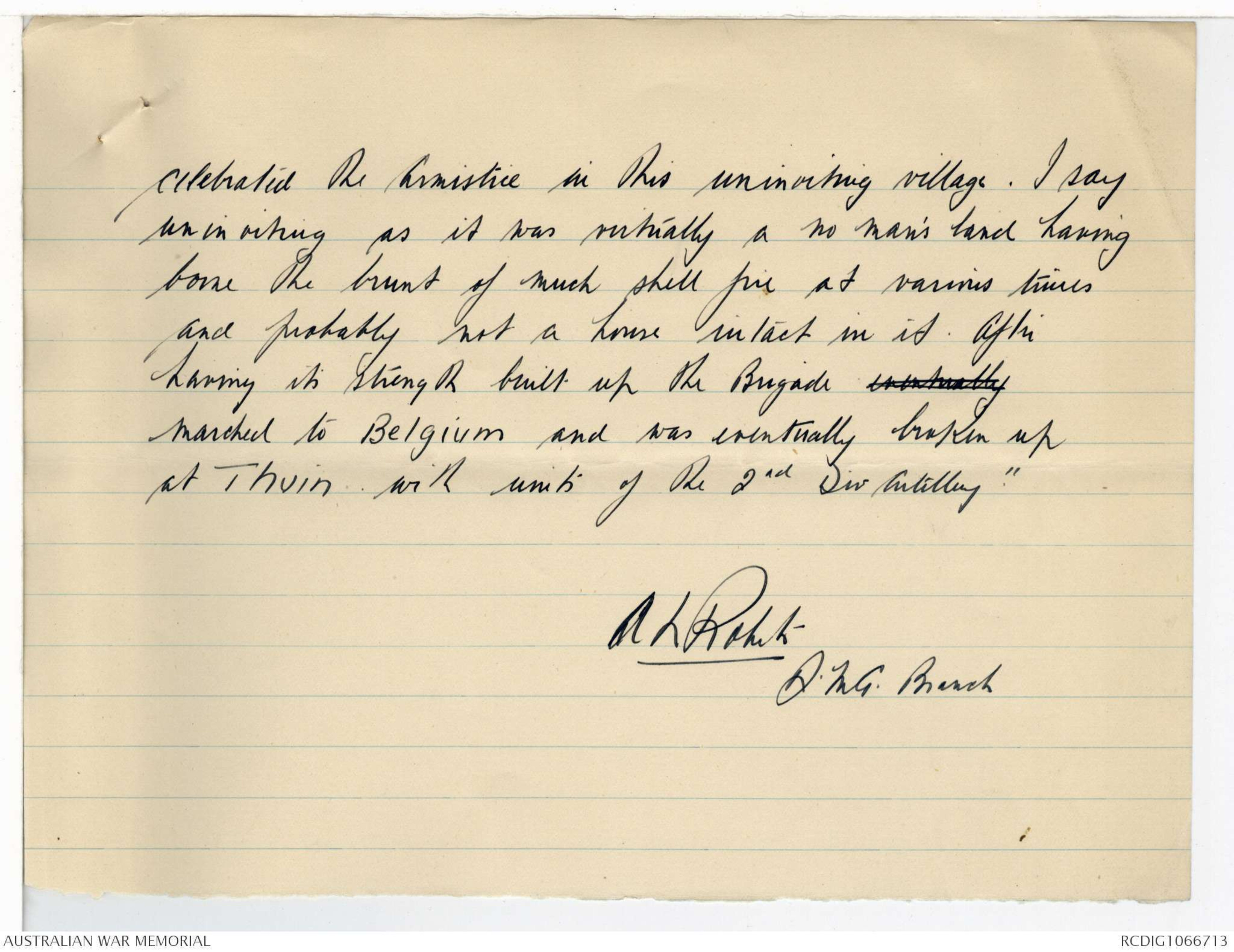
(2)
place before the teams entered the railway cutting. In front of
the teams, as they rested, was an off-shoot from the railway cutting
in the shape of a small spur, possibly 200 yards distant. As the
teams moved forward, two machine-guns opened fire from the direction
of the spur. From the right-hand team Sergeant Adam, Private D.
Lazarus and another crept forward and located one gun on the spur.
Dashing over some open ground, Private Lazarus reached the gun first
and shot two of the gunners with his revolver, thereupon six others
put up their hands and surrendered. For this courageous act, Lazarus
received the award of the Distinguished Conduct Medal. Scarcely had
this been done when the enemy gun on the left was located by some
members of the left-hand team. Making use of the cover afforded by
some straggling wheat, Lance Corporal N. C. Hammon and others got
within ten yards and a final rush and shots from their revolvers
induced the five or six occupants of a T shaped trench on lower ground
on the left of the spur to surrender. Immediately they did, one was
seen to tie a Red Cross badge on his arm.
The position of the two captured guns indicated that they had
been so placed to give left flank protection to the large group
situated on the railway embankment. At all events, their disposal
had the very important result of permitting the teams to enter the
railway cutting and engage the numerous guns on the embankment.
The way being clear, Lieutenant Wilkinson then took his teams to the
bend in the cutting and placed his guns guns at a point where the
gunners had a clear view of their targets and at the same time
giving a minimum of exposure of themselves. Then followed a few
hectic minutes. Two belts were fired from each gun, Lance Corporal
A. E. D. Marsh operating one and Private J.T. Bates and Corporal
Barrand (in turn) the other. Before such a dreadful concentration ^the opposition
helplessly and quickly faded out. On moving to the embankment, the
annihilating effect of the fire was revealed. No less than fourteen
enemy guns had been put out of action and out of nearly a
hundred men men estimated to have been on the embankment, about
thirty were killed and fifty wounded; the others made good their
escape to the rear. The way being now open, the teams proceeded to
Neville's Cross. On the right rear of the embankment, the teams
came upon two machine-guns mounted in shell holes, evidently so
placed to give right-flank protection to the embankment guns, but the
wiping out of the main line of defence appeared to have unnerved ^their teams them
because they retired hurridly to the rear; some of the ^Company gunners
taking pot-shots as they ran. Lieutenant Wilkinson fired his
revolver at one fat, ungainly German, who sprawled ludicerously into
a shell-hole with a wound in his hip, but others were firing and
claimed the hit. Other Germans rose from cover and were fired on,
the Pioneers appearing at this stage and joining in the shooting.
The low-lying ground at Neville's Cross did not commend
itself to Lieutenant Wilkinson so he took his teams forward till
he reached the high ground south east of Montbrehain and from that
vantage point was able to command a view for miles eastwards and
southwards. The guns were mounted without any immediate opposition
and feeling satisfied with his position, he sent a message to the
nearest Pioneer officer on his right rear, proposing that he come
forward with his men and establish a line on favourable ground. But
the Pioneer could not be moved. He insisted that he was at his
objective and intended to remain so. Actually, he was correct but
his position on the low ground was not a good one. A quiet period
followed and some of the teams did a little "souveniring" but
presently parties of the enemy were observed making their way up
the valley on the right of the guns so Lieutenant Wilkinson decided
that his advanced and unsupported position was becoming dangerous
and fell back to an embankment close to Neville's Cross. "We did
the return trip in double quick time" said Sergeant Adam "as small
shells and bullets were rather busy." The guns were again mounted
and fire directed on the parties in the valley which were scattered.
Later, reports indicated that massing was taking place in the same
quarter and again fire was opened. Further reports stated that
much havoc had been caused. x
(3)
About 4 p.m., the half-section sustained its only casualty
when Lieutenant Wilkinson received a bullet in the leg and was
carried out. Late at night, relief was provided by teams from
"B" Company II4th Machine Gun Battalion. The exchange was carried
through without mishap and the teams retired to camp near Bellicourt.
Such was the most effective blow delivered by the Company.
The operation was carried through without any assistance from the
Pioneers or tanks and affords a striking example of intelligent
initiative in leadership supported by courageous and dashing team
work. Admittedly an element of good fortune was present but that
would have been of no avail had the leader and teams not seized
their opportunities with determination and skill. Attacking emplaced
machine-guns in infantry fashion was not regarded as part of the
gun-team's training or work but as no other solution was at hand
the gunners - for the moment - assumed infantry tactics successfully.
The disposal of the enemy guns on the embankment was an opportunity
for gun work; to be seized quickly and skilfully.
The fortunes of war decreed that the blow should be reserved
for the Company's last fight and, incidentally, the last ground
fight of the A.I.F. The writer is not competent to assess its value
in relation to the Brigade attack as a whole. It must, however,
have been one of the determining factors in the Brigade's success
because the enemy guns on the embankment and vicinity commanded the
whole of the valley on the south of Montbrehain as well as most of
the sloping ground which fell away from the village itself. The
reports of the Brigade and Pioneer Battalion made but passing
reference to the Company's activities and it would appear that
both units were unaware of the latter's part in the operation.
Generous acknowledgement came from higher sources. In addition to
Private Lazarus' Distinguished Conduct Medal, Lieutenant Wilkinson's
leadership and enterprise brought him the award of the Belgian
Croix de Guerre while his principal gunners were decorated for their
part .Lance Corporal A.E.D. March received the Distinguished
Conduct Medal and Private J. T. Bates the Military Medal.
Add x
It should be added that throughout the operation Sergeant Adam
rendered invaluable service. Lieutenant Wilkinson subsequently testified
to the assistance received and added that each move was the outcome
of consultation with his Sergeant.
(3)
About 4 p.m., the half-section sustained its only casualty
when Lieutenant Wilkinson received a bullet in the leg and was
carried out. Late at night, relief was provided by teams from
"B" Company II4th Machine Gun Battalion. The exchange was carried
through without mishap and the teams retired to camp near Bellicourt,
Such was the most effective blow delivered by the Company.
The operation was carried through without any assistance from the
Pioneers or tanks and affords a striking example of intelligent
initiative in leadership supported by courageous and dashing team
work. Admittedly an element of good fortune was present but that
would have been of no avail had the leader and teams not seized
their opportunities with determination and skill. Attacking emplaced
machine-guns in infantry fashion was not regarded as part of the
gun-team's training or work but as no other solution was at hand
the gunners - for the moment - assumed infantry tactics successfully.
The disposal of the enemy guns on the embankment was an opportunity
for gun work; to be seized quickly and skilfully.
The fortunes of war decreed that the blow should be reserved
for the Company's last fight and, incidentally, the last ground
fight of the A.I.F. The writer is not competent to assess its value
in relation to the Brigade attack as a whole. It must, however,
have been one of the determining factors in the Brigade's success
because the enemy guns on the embankment and vicinity commanded the
whole of the valley on the south of Montbrehain as well as most of
the sloping In ground which fell away from the village itself. The
reports of the Brigade and Pioneer Battalion made but passing
reference to the Company's activities and it would appear that
both units were unaware of the latter's part in the operation.
Generous acknowledgement came from higher sources. In addition to
Private Lazarus' Distinguished Conduct Medal, Lieutenant Wiklinson's
leadership and enterprise brought him the award of the Belgian
Croix de Guerre while his principal gunners were decorated for their
part .Lance Corporal A.E.D. March received the Distinguished
conduct medal and Private J.T Bates the Military Medal. x
6th MACHINE GUN COMPANY ASSOCIATION
Incorporating 2nd Machine Gun Battalion
c/o George Batchelor Pty. Ltd.
12 McKillop Street,
Melbourne, C.I.
3/12/36
The Editor
"Reveille"
Sydney.
Dear Sir,
Many thanks for passing to me Mr. H. O. C. Hunter's
letter dated 7th September last. Incidentally, it is striking
evidence of the far-reaching c^irculation of "Reveille" that it
should bring a response from British East Africa in respect to
my claim that the 6th Machine Gun Company was the last A.I.F.
machine gun company to leave the line in France and that it fired
the last shot of the machine gun companies.
My thanks are due to Mr. Hunter for his congratulations
on the writing of the 6th M. G. Company's history as well as his
kind references to the unit.
With regard to the points raised in Mr. Hunter's letter,
I would like to make the following comments.
Apparently Mr. Hunter was writing from memory when he
penned his letter to you because his remarks are at variance
with his report on the doings of No.2 Section, 7th Machine Gun
Company at Montbrehain. According to the report, Mr. Hunter and
his Section left the vicinity of Bellicourt at I p.m. on the
day of the attack on Montbrehain (5th October) and reported to
the headquarters of the 2Ist Battalion. The C.O. directed him to
bring indirect fire on two points north of the village where the
enemy was reported to be massing and where movement was observed.
His weapons were used as a four gun battery and were in operation
at 3.30 p.m.x About a thousand rounds were ^also fired at hostile air
craft. Mr. Hunter goes on to remark that "At 8.30 p.m. the C.O.
21st Battalion gave me orders to withdraw, which I did. The Section
moved to west of Hargicourt".
It is safe to assume that Mr. Hunter lost no time in
complying with the order for withdrawal. In that case, he would
have been clear of the village and environs well before midnight.
The 6th Company with eight of its guns in the front line with the
infantry was not able to report its relief complete until 12.30
on the morning of the 6th October. On the evidence, there can be no
[*x from a point close to the village church*]
JMC
(2)
doubt whatever that the 6th Company was the last to leave the line.
As to my other claim that the 6th Company fired the last
shot of the machine gun companies in France, the evidence clearly
and definitely supports my contention. Mr Hunter's report states
that his guns were in action ^ (indirect fire) at 3.30 in the afternoon. His fire
directed against hostile aircraft may have taken place at a later
hour but low-flying enemy machines would hardly afford a target
at dusk when the Company's line guns on the north of the village
fired on enemy movement in their vicinity.
I appreciate the friendly tone of Mr. Hunter's letter and
will have pleasure in giving due credit in the 6th Company's history
for the part played by the Section from the 7th Company. I may
add that the history has received very favorable comments from
Sir John Gellibrand who has written a Foreword and that it is
almost ready for the printer.
Yours faithfully,
W.A. Carne
W. A. Carne.
P.S. I am enclosing Mr. Hunter's
letter herewith.
WAC
P.P.S. Will you please note to send me three copies (in addition
to my usual copy) of the issue of "Reveille" in which you
insert Mr. Hunter's letter.
Should you insert my reply in a subsequent issue, I desire
three extra copies also. Payment will be remitted on
receipt.
WAC
[*Acknowledged
Shown to Col Butter*]
Army Headquarters
Melbourne
May 27th 1937
Dear Captain Bean
It has occurred to me that the following
notes may be of some use to you in the compilation of
your final volume of the A.I.F. in France. I cannot
quote actual dates but being Adjutant of the 6th Army
Bde , AFA, at the time, the circumstances have always
remained clear in my mind.
"The last area that this Brigade was in action
was in front of Busigny. From there it was sent back
to the outskirts of Ameins to recuperate and build up
its strength of both men and horses. I might here mention
that spells were few and far between as far as Army F. A Brigades
were concerned. They always seemed to be holding the line
relieving other brigades. backing up for special jobs,
side slipping to help others etc. Actually when the
Brigade arrived in rest area its strength, although
down, was sufficient to carry on, but, from some
unexplainable reason a reaction came over its personnel.
Whether it was from the tension of a long period of
fighting and moving or from the thought that it would
be required in the line again I cannot say.
At any rate men seemed to have very little resistance
and the number reporting sick was outside normal
proportions, so much so that the Brigade Medical Officer,
Major CC. Simpson MC established a rest home in
order to possibly save evacuationg men who would
normally soon recover but would not be returned to
the Brigade for some time due to the cumbersome process
of returning them through the Base Depot. However the
Rest Home had to be abolished as men were genuinely
sick and had to be sent back for more careful
treatment some of whom eventually died. On a
stocktaking of our personnel resources being made it
was apparent that the Brigade was no longer an effective
fighting unit. It did not have sufficient men to
render it mobile and this situation was clearly represented
to Corps Headquarters by Major HSW Parker D.SO. who
temporarily commanded the Brigade during the absence
of Lt Col. Hal Harold Cohen CMG D.S.O. on leave.
Notwithstanding this representation, about two days later,
we received orders, at midnight, to move back to the
line and to pass a starting point, 8 hours later - at
8 a.m. No immediate preparation for the move was made
but a message was sent back to Corps H.Q. drawing
attention to our previous report as to our immobility.
At 3 am we were again definitely instructed to
carry out the move. Orders were immediately typed
and distributed to batteries, but, in order to get them
on the move, it was necessary to break up the Brigade
Ammunition Column. Mu Mule teams and men
were distributed to Batteries to build up their
requirements and the vehicles and ammunition of
the Column parked under guard. Although the
Batteries were distributed over an area of about five
miles, personnel were settled in comfortable billets and
orders did not reach battery commanders until 4.30. am
The Brigade was once again on the move at 8. am.
The day's march ended at Proyart where the
G.O.C, R.A. Aust Corps, Brig General WA Coxen came
along and queried the necessity of leaving our
main source of ammunition supply, the retreats of
the Brigade Ammunition Column, at Amiens. On
being shown copies of our strength returns he
immediately cancelled the move and the Brigade
celebrated the Armistice in this uninviting village. I say
uninviting as it was virtually a no man's land having
borne the brunt of much shell fire at various times
and probably not a house intact in it. After
having its strength built up the Brigade eventually
marched to Belgium and was eventually broken up
at Thuin with units of the 2nd Div Artillery."
[[? A L. Robets]]
D.MG. Branch
 Marisa Bortolotto
Marisa BortolottoThis transcription item is now locked to you for editing. To release the lock either Save your changes or Cancel.
This lock will be automatically released after 60 minutes of inactivity.